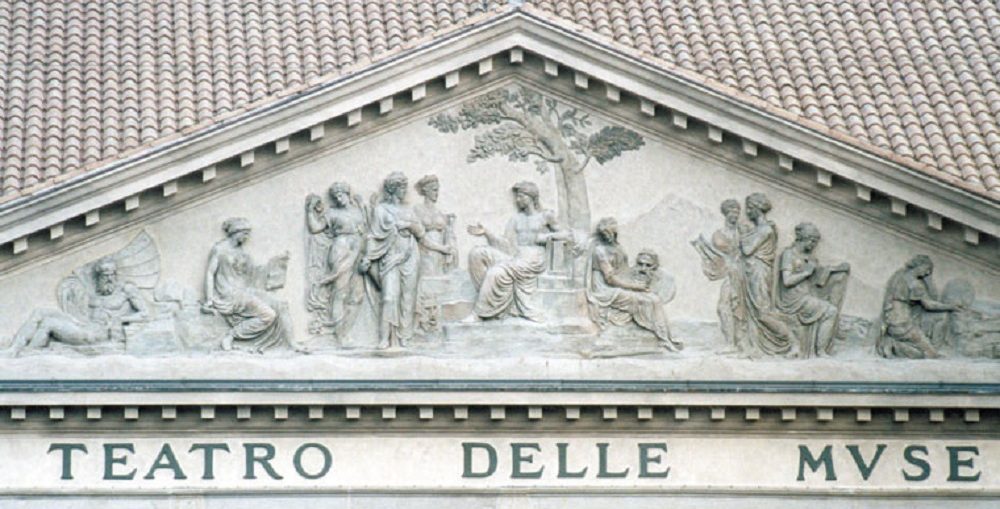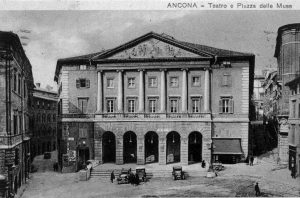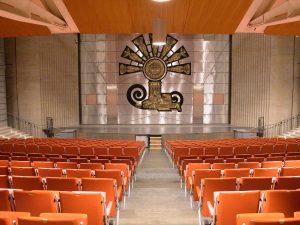
 Costruito nel 1827 su progetto di Pietro Ghinelli in stile neoclassico con una sala tipica a ferro di cavallo e 4 ordini di palchi, il Teatro delle Muse di Ancona è stato riaperto il 13 ottobre 2002 come un nuovo oggetto architettonico ricco di una vita propria fatta di evocative giustapposizioni. Danneggiato dai bombardamenti della seconda guerra mondiale è rimasto inattivo per molti anni. Il nuovo progetto dei due architetti Danilo Guerri e Paola Salmoni,finito nel 2002, si è basato sulla ricerca di un rapporto armonico tra l’interno moderno e le facciate neoclassiche, conservando quanto ha potuto (la scala di ingresso, il vecchio atrio) e creando una continuità concettuale con lo spazio urbano esterno, là dove si pone l’enfasi degli spazi più pubblici del teatro (atrio, foyer, sala delle feste). Il risultato è un teatro-piazza con materiali che riprendono l’anima nomade e precaria della “rappresentazione” (legno e metallo, graticciati e ballatoi) e quella di monumento urbano (mattoni e pietre, forme retoriche e significati collettivi).
Costruito nel 1827 su progetto di Pietro Ghinelli in stile neoclassico con una sala tipica a ferro di cavallo e 4 ordini di palchi, il Teatro delle Muse di Ancona è stato riaperto il 13 ottobre 2002 come un nuovo oggetto architettonico ricco di una vita propria fatta di evocative giustapposizioni. Danneggiato dai bombardamenti della seconda guerra mondiale è rimasto inattivo per molti anni. Il nuovo progetto dei due architetti Danilo Guerri e Paola Salmoni,finito nel 2002, si è basato sulla ricerca di un rapporto armonico tra l’interno moderno e le facciate neoclassiche, conservando quanto ha potuto (la scala di ingresso, il vecchio atrio) e creando una continuità concettuale con lo spazio urbano esterno, là dove si pone l’enfasi degli spazi più pubblici del teatro (atrio, foyer, sala delle feste). Il risultato è un teatro-piazza con materiali che riprendono l’anima nomade e precaria della “rappresentazione” (legno e metallo, graticciati e ballatoi) e quella di monumento urbano (mattoni e pietre, forme retoriche e significati collettivi).
Di grande rilevanza artistica il sipario tagliafuoco, unico in Europa, firmato dallo scultore Valeriano Trubbiani.
Lo scultore Valeriano Trubbiani immagina l’enorme saracinesca che chiude il palcoscenico di 360 metri quadrati come la fiancata di un’antica nave fitta di un fasciame in acciaio la cui polena brilla del bronzo di altorilievi incassati su fondo nero. Un beneaugurante sole ride al centro di una sorta di trionfo barocco con quattro metope, l’arco di Traiano e un curioso cavallino che sembra voler fuggire dall’ostensorio di una sacra rappresentazione.
Teatro delle Muse – piazza della Repubblica
Teatro delle Muse
TEATRO DELLE MUSE – CORELLI
Built in 1827 on a project by Pietro Ghinelli in the neoclassical style, it has the typical horseshoe shape and 4 orders of cabins, the Teatro delle Muse in Ancona has been reopened on the 13 October 2002. It is now a new and rich building with a life of its own, made of evocative juxtapositions. Since it was damaged by the bombings of World War II, it had been closed for many years. The new project by the architects Danilo Guerri and Paola Salmoni was completed in 2002. Its rationale is the struggle for a harmonious relationship between the modern interior and the neoclassical facade. The project aimed to the preservation the surviving parts (the entrance staircase, the old hall) and to the creation of a conceptual continuity with the city outside, where the emphasis is on the public areas of the theater (hall, foyer, reception room). The result is a theater-square made of materials that evoke the nomadic and precarious spirit of the “show” (wood and metal, trellises and galleries) but at the same time the spirit of the monument (bricks and stones, rhetorical shapes and collective meanings).
The fireproof curtain is also of great artistic significance. It was made by the sculptor Valeriano Trubbiani and it is unique in Europe.
TEATRO DELLE MUSE – CORELLI
Der Theater wurde 1827 von Pietro Ghinelli in neoklassischen Stil mit einer typischen Hufeisenform und Tribünen auf 4 Reihen geplant. Das Theater wurde am 13. Oktober 2002 wieder eröffnet.
Heute zeigt das Theater eine neue, reiche Architektur, die von bezeichnende Nebeneinanderstellung besteht. Das Theater erlittet die Bombardierungen des zweiten Weltkriegs, und aufgrund der angerichteten Schäden war seit vielen Jahre geschlossen. Das neue Projekt von den Architekten Danilo Guerri und Paola Salmoni beendete im Jahre 2002. Grundlage des Plans ist der Kampf um eine harmonische Beziehung zwischen die moderne Innenseite und die neoklassizistische Fassade. Das Ziel des Projekts waren die Erhaltung der bleibenden Teile (Eingangstreppe, alter Saal) und die Erschaffung einer konzeptionellen Kontinuität mit der Stadt. Schwerpünkte waren die öffentliche Bereiche des Theaters (Flur, Foyer, Empfangsraum). Das Ergebnis ist ein Theater-Platz mit Materialien, die am umherziehenden und vorläufigen Geist des Schauspielers (Holz und Metall, Gitter und Treppenabsätze) sowie am Geist des Denkmals (Backstein und Gestein, rhetorische Formen und kollektive Bedeutungen) erinnern.
Der Vorhang hat auch eine große künstlerische Bedeutung. Er wurde vom Bildhauer Valeriano Trubbiani hergestellt und er ist in ganze Europa einzigartig.

